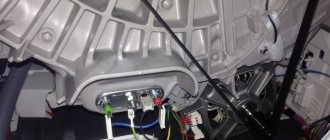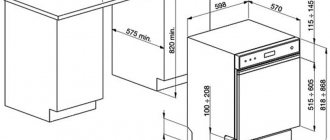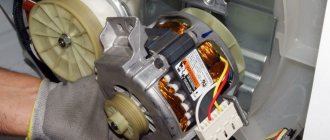In the operation of dishwashers, the problem of lack of water heating is quite widespread. This is often due to the fact that in most modern models. A large number of elements are used. Which directly affect the heating of water. In the circuit, in addition to the heating element itself (heating element), sensors, switches, fuses, wiring, etc. may fail.
The more elements in the circuit. The less reliable it is. If the dishwasher does not heat the water, you will not be able to fully use it. After all, the temperature of the water during washing. This is one of the main parameters. Which are involved in the dishwashing process. In some cases, users do not immediately notice that the dishwasher is not heating the water. Many people try launching other washing modes and programs. But unfortunately this does not change anything.
How can you tell if your dishwasher is not heating water?
Or your dishwasher showed an error on the display that it is not heating. Or something alarmed you about her work. And you understand. That most likely there is some kind of defect. Since the dishes were very poorly washed and covered in drops. For different dishwashers. The washing logic for a faulty heating element may vary.
Error in the dishwasher if there is no water heating
- Bosch/Siemens/Neff error E09
- Electrolux/AEG/Zanussi error i60
- Ariston error AL10
- Samsung error E3
- Beko error H2
- SMEG error E3
- ASKO error F1
Some models may stop after 15 minutes and indicate that there is a malfunction. Others, on the contrary, will wash as if nothing had happened. Some dishwashers. With a faulty water heating circuit. Washing time increases significantly. To understand whether heating occurs or not. It is enough to run a short wash cycle (not rinsing) and periodically open the door and test the water.
The water doesn't heat up - what's the problem?
Often there is a problem of cold water in the tank. If the dishwasher does not heat the water, as a rule, this indicates a breakdown of the heating element. But often the heating element is working properly, but the reason lies elsewhere. Sometimes, the water remains cold due to the wrong choice of washing program, or a clogged drain filter. The cost of fixing the problem depends on correct diagnosis.
So, the main reasons for the lack of water heating are:
- Breakage of the heating element.
- Thermostat failure.
- Damage to the control unit (popularly called “brains”).
Breakage of heating element
If the heating element breaks down, it should be replaced with a new one. Heating elements cannot be repaired and if they burn, they cannot be restored. Before rejecting the heating element, you should check its contacts. It happens that they oxidize due to overheating and become covered with plaque.
The contacts of the wires feeding the heating element are also covered with plaque. Because of this, contact may be lost and the heating element may not work. In this case, it is recommended to replace the contacts on the wires, re-crimping them with new ones, and clean the heating element contacts until they shine.
Some craftsmen recommend using copper paste when connecting the heating element. It is used to carefully lubricate the contacts of the heating element so that the paste does not get on anything else. Lubricate lightly to avoid even the slightest contact with other parts of the heating element or dishwasher. Then put on the terminals
wires Copper paste will adhere to the contacts and protect them from plaque formation and loss of contact. Also, you should check the wiring itself that powers the heating element.
IMPORTANT! Copper paste is a conductive material. When working with it, you should be careful!
Heating element for Bosch dishwasher.
Thermostat failure
Why doesn't the dishwasher heat the water? Thermostat failure is the second possible reason for the lack of water heating. It is diagnosed only after the heating element has been tested and its performance has been confirmed. You can check the thermostat only by removing it and measuring its resistance at different temperatures of the thermostat housing.
Each thermostat has its own values. You need to search for them on the Internet for each thermostat model separately.
Before taking measurements, the sensor contacts should be cleaned until shiny. If the sensor is faulty, it is replaced with a new one. Before installing a new thermostat, you should check its wiring. If the wire contacts are oxidized, they need to be replaced.
Dishwasher thermostat.
Control unit failure
If the thermostat and heating element are in order, you need to check the control unit itself. It is impossible to diagnose this part at home. To do this you will need a diagnostic scanner. But you can visually inspect it. Perhaps some contacts are burnt, and you can replace them yourself. If everything is visually in good order, but the control unit does not work, then only an experienced electronics engineer can repair it.
The dishwasher does not heat or dry.
Drying the dishes occurs at the last stage of washing. During the last rinse. Depending on the selected program. The dishes heat up to 60-70 degrees. Then the water from the dishwasher is drained and the drying process occurs. Drying dishes in dishwashers works by evaporating droplets. This type of drying is called condensation drying. In any dishwasher. Regardless of whether such additional “chips” are used in the device. Like turbo drying or zeolite drying.
Condensation drying is used first. And options with turbo dryers. They are just auxiliary. And by themselves, without condensation drying, they are not able to dry the dishes. If the dishes are washed, but still not completely dried. In this case, other problems may be the cause. Not related to water heating.
Everything is technically correct, but the water is still cold
In addition to these malfunctions, the reason for the lack of heating of water in the dishwasher may also be a clogged problem. The machine cannot fill and drain water on time, water does not circulate well between the dishwasher tanks. Because of this, glitches in the program may occur and the machine will not work as expected.
In order to check if the drains are clogged, you need to visually inspect them, remove the filters and clean them well.
To check, you can open the dishwasher door slightly during operation. The program will pause. You need to pay attention to whether water accumulates at the bottom of the tank. Ideally, it should not accumulate. If there is water at the bottom, and clearly more than usual, then you should clean the drains of the machine.
To prevent the machine from clogging, it should be used with special cleaning chemicals. It helps both to better wash the dishes themselves and to avoid clogging the drains of the machine. It is also recommended to run a long wash program once a month in an empty car using a special washing gel or powder.
The dishwasher has stopped heating the water and will not dissolve the tablet.
This feature may be due to a lack of heating or other problems. If during washing. Only cold water is used. The tablet may only partially dissolve. In this case, it usually spreads down the door. There may also be a small part left at the bottom, under the basket.
Without hot water, the washing result will be very far from the standard. If you notice that the dishes are poorly washed. Drops remain on it and after the completion of the washing cycle (If you open the door immediately) there is no characteristic steam. In this case, most likely your dishwasher has stopped heating the water.
Why isn't heating happening? What could be the reasons?
To answer this question. You need to understand what elements are involved in the process of heating water. On the image. Shown is a typical dishwasher heating circuit diagram. Violation of any of the elements. It can lead to complete failure of the entire circuit. So it works intermittently.
- Heating element - The heating element itself
- Control module - The electronic unit controls all sensors and supplies voltage to the heating element depending on the temperature readings
- Thermal sensor - an element that measures temperature
- Thermal fuse (Sometimes several) If the permissible temperature is exceeded, it turns off the heating element
- Water pressure sensor - One of the elements. Serves to protect the heating element from overheating if the dishwasher tries to turn on the heating element without water. Or with a small amount of it.
- Water level sensor - in some dishwashers. The heating circuit passes through the water level sensor. No water No heating
- Engine speed sensor - the element controls the process of water circulation in the system. If circulation does not occur. The voltage from the heating element is “relieved”
- Electrical wiring. Simply put, the wires connecting all these elements together
The water does not heat up: causes and description of the problem
The main reasons why equipment stopped heating water normally:
| Crash | Description of the problem |
| The heater has burned out. | The design of the PMM includes a flow-through water heater or, more often, a heating element. Externally, the part resembles the one installed in washing machines, but works on the principle of an electric kettle. Due to hard water, over time it becomes covered with a thick layer of scale and fails. It is impossible to repair the part; it must be replaced with an original analogue. |
| The temperature sensor (sensor, thermostat) is broken. | The sensor is present in the design of any dishwasher. It is a sensor that determines the water temperature and reports the received data to the electronic board. If the process is disrupted, the command unit does not put the heating element into operation, and the machine washes the dishes without hot water. The thermostat cannot be repaired; it must be replaced. |
| The electronic control module is malfunctioning. | Electronic PMMs are equipped with a “brain” - an electronic board that analyzes information coming from various components of the device and issues commands to turn them on/off. If the machine stops heating water, it is possible that the module has failed and is not starting the heating element to work. You need to flash the electronic board or replace the unit with a new one. |
What can affect the operation of the heater?
May affect the operation of the heater in the dishwasher. Scale on the heating element. As soon as the heater becomes covered with scale. Overheating occurs. And it may fail.
Water getting into any element of the heating circuit. If there is a leak in the car. Water getting on sensors and wiring. It can negatively affect both the heating system and the entire operation as a whole.
Untimely cleaning of filters can affect both the water level sensor. Same goes for the pressure sensor. Residual deposits enter the system and can damage the sensors. Or distort their testimony
Life time. Not an unimportant factor. For some devices, the service life of the elements may simply be limited.
Clearing a clogged filter
The garbage filter is rightfully considered one of the main components of a dishwasher. Its functional task is to prevent food debris and dirt waste from penetrating the main working elements. Dirt gradually collecting in the filter cavity prevents normal water circulation in the device, so the heating element turns off and the dishwasher does not heat the water. To normalize the operation of the machine, it is necessary to clean the filter.
The bottom line is that when you turn on the washing program, water should communicate well between the storage tank and special containers. At this time, the heating element maintains a constant temperature necessary for high-quality washing. If the filter is partially or completely clogged with debris, circulation becomes far from normal. Water accumulates in the tank, and the system will be forced to replenish reserves using cold tap water. Ten won't be able to heat it up.
It is important for the consumer to remember that in order to avoid this malfunction, it is necessary to thoroughly clean the dishes before placing them in the dishwasher.
It would also be a good idea to look into the storage tank while working. If it fills with water, it is necessary to promptly clean the filter. As a result, normal circulation will be restored and the problem with water heating will disappear, unless the heating element fails due to a blockage or the thermistor does not burn out synchronously.
What to do if the dishwasher does not heat the water?
An important issue is the way to solve the problem. Undoubtedly, it is individual for each case. Somewhere you can get by with cleaning. And somewhere you will need to replace expensive elements. There is no universal remedy.
You can try washing the filters yourself. Reset the program. And test the dishwasher on different washing modes. There may have been a short-term glitch. And after a restart everything will work.
If the problem does not go away. Unfortunately, this cannot be done without the help of a qualified specialist. For some dishwashers, diagnosing the problem is quite easy. For others it's the opposite. The abundance of elements in the heating circuit. Can cause difficulties, especially if the problem is not permanent...











